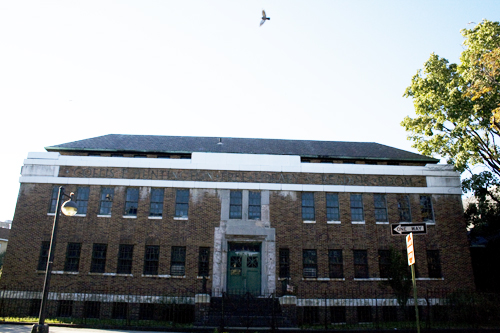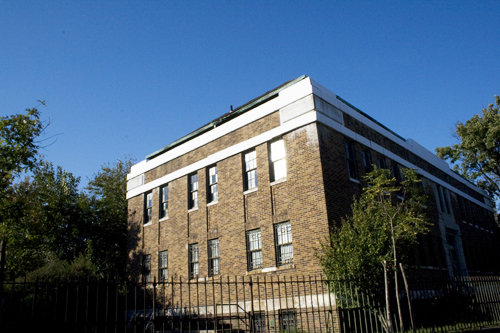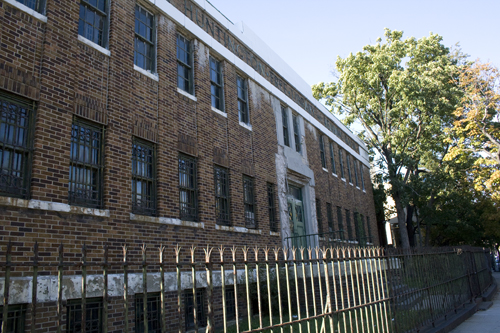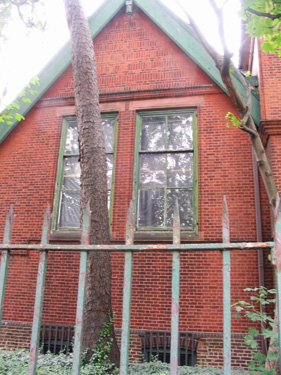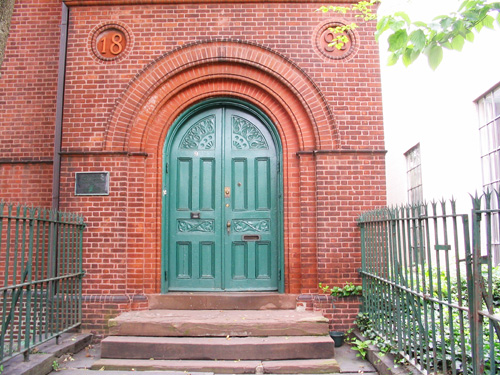Huntington Free Library
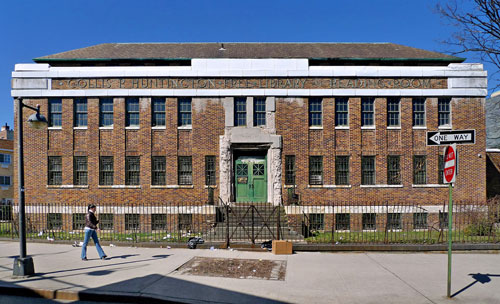
Huntington Free Library and Reading Room
9 Westchester Square (Westchester and Tratman Avenues)
Frederick Clarke Withers, 1882 and William Anderson, 1891
This cluster of small buildings next to the elevated tracks began as the work of a celebrated nineteenth-century architect, and subsequently attracted the attentions of a millionaire builder of railroads, a voracious collector of American Indian artifacts, and a squadron of lawyers.
The executors of the late Peter Van Schaick, a wealthy tobacco merchant who had left $15,000 for the creation of a free reading room to be donated to the village of Westchester (the neighborhood of today’s Westchester Square,) hired the architect Frederick Clarke Withers in 1880. Among Withers’ surviving buildings is the polychromed and steepled Jefferson Market Courthouse in Greenwich Village, in 1885 voted one of America’s ten most beautiful contemporary structures. A touch of the courthouse’s Victorian picturesque style, appropriately tamed and scaled-down, appears again in Withers’ modest Bronx commission.
Although the building’s footprint is a plain rectangle with a protruding bay at the rear, each of the rooms is given a distinct exterior shape and roofline, forming a tight ensemble of contrasts. The three-storey tower with its arched entrance is crowned by a steep pyramidal roof. To its right is the sharply pitched gable end of the main room, its two high windows facing Westchester Avenue. Showing from behind the tower is the low hip roof of the game room, perpendicular to the axis of the reading room and ending in a curved apse. The whole group pivots around a high central chimney. Surface ornament is restrained: a brick compound-arch entrance, a meandering stringcourse, which ties together the façades, a terracotta name panel and roundels with the date.
That date should have been 1882, when the Van Schaick Reading Room was completed and presented to the village. But the citizens, reflecting on the taxes, which would be required to maintain their new library, chose to refuse the bequest. (The village of Westchester seems to have been notably contrarian. In an 1894 referendum, it rejected consolidation with the western Bronx and the City of New York, a vote the exasperated administration simply ignored.) The community’s close-fistedness was derided in the editorial columns of The New York Times, but the reading room went unused until railroad magnate Coliss P. Huntington, who had recently moved to nearby Throg’s Neck, took matters into his own hands. Huntington bought Withers’ building, had an unpicturesque addition built at the west end, replaced the Van Schaick name over the entrance, redated the roundels, and in 1891 opened his institution to the village as the Huntington Free Library.
But the vicissitudes of the little buildings were not over. In 1930, Huntington’s stepson and heir invited his friend George Heye, founder of the Museum of the American Indian, to house its large library at Westchester Square, building for it the yellow glazed-brick and concrete addition now to be found, severely dilapidated, to the south of the original buildings. When the Heye Museum sold its holdings to the Smithsonian Institution in 1990, the Huntington Library refused to part with its collection, now valued at $8 million, which had become the centerpiece of the institution. After fifteen years of litigation, the library’s right of possession was upheld, but the victory was a pyrrhic one, legal fees having exhausted the Huntington endowments. Ironically fulfilling the doubts of Van Schaik’s original heirs, the library found that it couldn’t afford to conserve its valuable manuscripts or maintain Withers’ landmarked building.
There has been a second rescue, Cornell University agreeing in 2005 to house the Heye collection and pay the reading room’s operating expenses. The Huntington still shelves books from the early years when it was one of only three free libraries north of the Harlem River, as well as a collection of Bronx historical materials.
David Bady
Photographs:
Kareema Hussein
